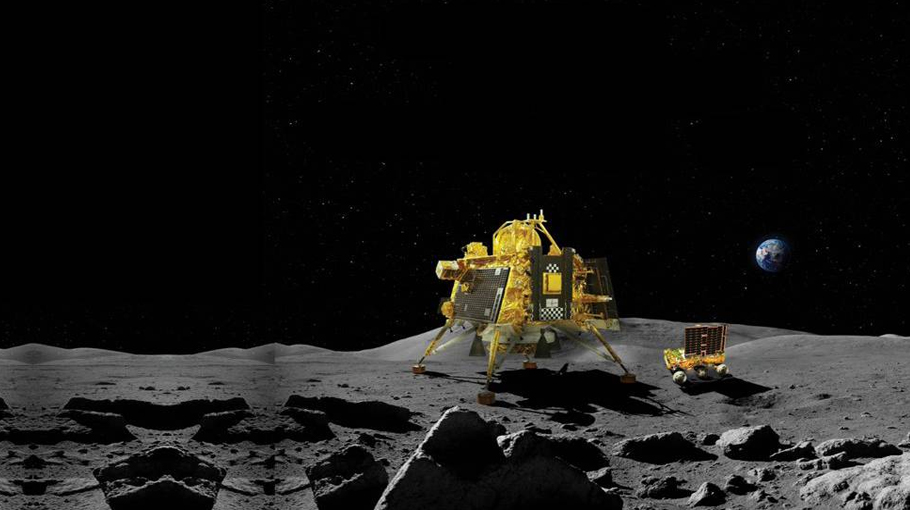India is on the moon and history is made
It was India’s date with destiny as the superpower space club has finally been breached

A big step from Chandrayaan-3 and a giant leap for India. Through the last ‘minutes of terror’ as the spacecraft’s lander approached the lunar surface a nation of 1.4 billion collectively had its heart in its mouth, a pin could have dropped anywhere in the country and be heard. And then, the biggest comeback story of our times, India was on the moon and history was made.
The country’s space agency Isro kept its promise, it was a storybook landing quite as celestial as the space Chandrayaan-3 lander touched down on.
The applause that broke out in the control room as it entered the final vertical descent phase where the altitude was brough down from 800 meters was contagious but nervous, it was only when with two engines firing and at the reduced height of 150 meters the hovering changed to approach, that the magnanimity of what was unfolding hit home.
From there the controlled landing was a matter of seconds and the ovation at Indian Space Research Organisation (Isro) richly deserved was echoed across the country.
Vikram Lander — named after Vikram Sarabhai, widely regarded as the father of India’s space programme entered the lunar orbit on Aug. 5 moving without a hitch to Wednesday’s touchdown as Isro scientists inspired a nation on how lessons from failure can script one of the biggest success stories.
4 years ago, Chandrayaan-2 faltered at the end stage when its lander with a rover in its belly crashed despite the successful deployment of an orbiter. Poignant images of the then chief of Isro K Sivan breaking down and describing the final moments as ’15 minutes of terror’ have haunted not just the scientific community.
Isro promised that it had learnt from the mistakes of September 2019, and it kept its promise. While this is a moment for science, our scientists deserve every bit of the recognition that will hopefully come their way.
What makes India’s lunar mission even
more remarkable is that it is the first
country to land on the unexplored
south pole that Nasa calls being ‘full
of mystery, science, intrigue.’ It is literally
India’s go big or go home moment
The landing of Chandrayaan-3 which means mooncraft in Sanskrit has not just united a polarised country behind it in a moment of all-encompassing nationalism, it has also boldly gone where only three countries have gone before. India is now a member of an elite club that includes US, China, and the erstwhile USSR.
Dark side of the moon
What makes India’s lunar mission even more remarkable is that it is the first country to land on the unexplored south pole that Nasa calls being ‘full of mystery, science, intrigue.’ It is literally India’s go big or go home moment. It chose to reach the moon.
The south pole is full of craters which are believed to be rich in water ice that could aid future habitation on the lunar surface through the supply of drinking water, oxygen, and fuel — resources required as future manned missions to the moon are no longer unthinkable. A 1967 United Nations Outer Space Treaty stipulates that no country can lay claim to the moon but has no restrictions on commercialisation. You would imagine Elon Musk is already on it!
India’s mission is all the more special as it landed on the dark side of the moon. Scientists are unanimous, this landing on a side facing away from earth where a large area remains in darkness was
challenging.
Away from the sunlight, these craters have some of the lowest temperatures in the solar system making it possible for ice to stay at stable temperatures.
A nail-biting finish
The anticipation for Chandrayaan-3 which was launched on 14 July from Sriharikota in Andhra Pradesh had been building up since the crash of Russia’s lunar mission on Sunday when the Luna-25 spacecraft spun out of control and hurtled into the moon in what was Russia’s first moon mission in 47 years.
‘Race in space’ screamed recent headlines as although launched a month after Chandrayaan-3, Luna-25 overtook Vikram Lander only to lose contact as it was entering its pre- landing orbit. It was India’s date with destiny.
By Monday things were on track as Isro tweeted that two-way communication had been established between Vikram Lander and Chandrayaan-2 orbiter that continues to map the moon and became a backup channel for communication for the space agency.
In the countdown to a nail-biting finish of finding a safe landing spot — a 4km x 2.4km- Isro has been wetting the country’s appetite by releasing photos of rthe lunar surface taken by the lander.
India’s success has been keenly watched across the globe, the superpower space club has finally been breached and will not just encourage countries like Israel and Japan whose privately funded missions failed once, countries will also look to ape the India story of marrying science, success, and a cost-effective budget.
Putting India’s $75 million mission cost in perspective, Christopher Nolan’s Interstellar, a movie on space exploration was reportedly made on a budget of $165 million.
India’s dream to conquer the moon began in 2009 with Chandrayaan-1 that first revealed the presence of frozen water on the lunar surface. With its third mission in 15 years, it seems the moon was almost a calling, the final frontier.
Most Indian households have at least one childhood lullaby or a tale centred on the moon. We now have a new story to share and by far it’s the best one.
Jyotsna Mohan is the author of the investigative book ‘Stoned, Shamed, Depressed’. She was also a journalist with NDTV for 15 years.
Source: Gulf News




